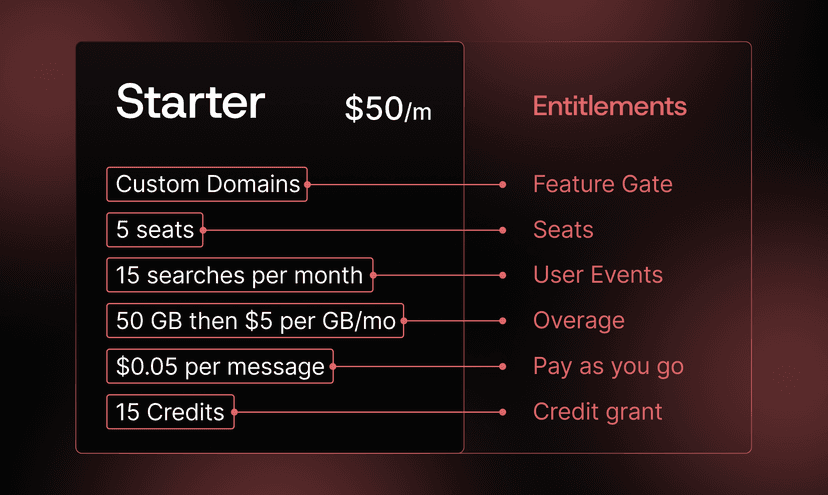

TL;DR: Entitlements determine what features and resources a customer can access based on what they've purchased. Think of them as permissions for companies rather than users.
Entitlements are one of the most important concepts for understanding how to monetize products, yet they're often overlooked or misunderstood.
Here's a useful way to think about them: users have permissions, companies have entitlements.
If you've built any kind of multi-user application, you understand permissions. They're the system that determines what individual users can do within your product. "Can this user view a document? Which users can edit a dashboard? What roles are allowed to approve a request?" These are the fundamental questions that permissions answer.
Entitlements work the same way, but at the company or account level. They determine what features, limits, and resources a customer can access based on what they've purchased. "Can this company access advanced reporting features? How many seats do they have? What's their API rate limit?" These questions are the providence of entitlements.
Like permissions, entitlements are a fundamental architectural concern in modern applications. As SaaS products have evolved from simple tier-based pricing to complex combinations of seats, usage limits, feature access, and hybrid models, the question of "what can this customer access?" has become increasingly complex. This article is about understanding entitlements as a concept, why they matter, and how to think about them as a distinct layer in your product architecture.
At its core, an entitlement system determines what features, limits, and resources a customer can access based on what they've purchased. It's the layer that translates commercial agreements (plans, add-ons, custom contracts) into technical capabilities within your product.
Entitlements show up in different forms depending on how you've structured your pricing. Some common types include:
Feature gates — Binary access to capabilities. (e.g., "Can this company export to PDF?" or "Does this account have SSO enabled?")
Usage limits — Metered entitlements with defined thresholds (e.g., "This customer gets 10,000 API calls per month" or "They can store up to 100GB of data")
Seat-based entitlements — How many users can access the product (e.g., "This company has purchased 25 seats")
Rate limits — Operational constraints tied to pricing tiers (e.g., "Free tier customers are limited to 10 requests per minute")
Entitlements can play a dual role in your product, controlling both what customers can access and how much they pay. Feature gates and usage limits can determine which capabilities are available. Usage-based billing and feature add-ons can influence the cost. Most modern SaaS products use a combination of these, creating plans that match what different customer segments want, and are willing to pay for.
Modern SaaS and AI companies move fast. Product teams ship new features weekly. Sales teams experiment with packaging. Marketing runs promotional campaigns. But many companies find that changing what customers can access (their entitlements) is slow and expensive, creating a bottleneck that constrains the entire business.
Entitlements sit at the heart of how you monetize. Every pricing change ultimately comes down to changing what customers can access and under what terms. Launching a new plan tier, adding usage-based components to seat-based pricing, creating promotional access to premium features, adjusting rate limits, bundling products — all of these require changing entitlements.
The companies that can iterate quickly on pricing and packaging have a significant competitive advantage. They can respond to market feedback, test new monetization strategies, and capture revenue opportunities that slower competitors miss. Making sure your system can model entitlements well and change them easily is critical to that agility.
Entitlements aren't just about what's in your standard pricing tiers. They also need to handle the exceptions and edge cases that emerge as you sell. Trial extensions for promising prospects, custom contract terms negotiated by enterprise sales, customers on legacy plans, and one-off deals to close strategic accounts are all common occurences for modern companies.
A well-designed entitlement system handles both the standard plans and the exceptions without requiring code changes for every special case. The alternative (hardcoding these rules throughout your application) creates technical debt that slows you down and increases the risk of breaking existing customer access when you make changes.
Users have permissions that control what actions they can take. Companies have entitlements that control what features and resources they can access. Both are fundamental questions that your product needs to answer, and both deserve deliberate architectural consideration. Understanding entitlements provides a clearer mental model for how monetization works in your product.
As your pricing evolves and your product grows more complex, the way you model and manage entitlements will increasingly impact your ability to iterate on monetization. It's worth thinking about early, before exceptions and edge cases accumulate into technical debt.